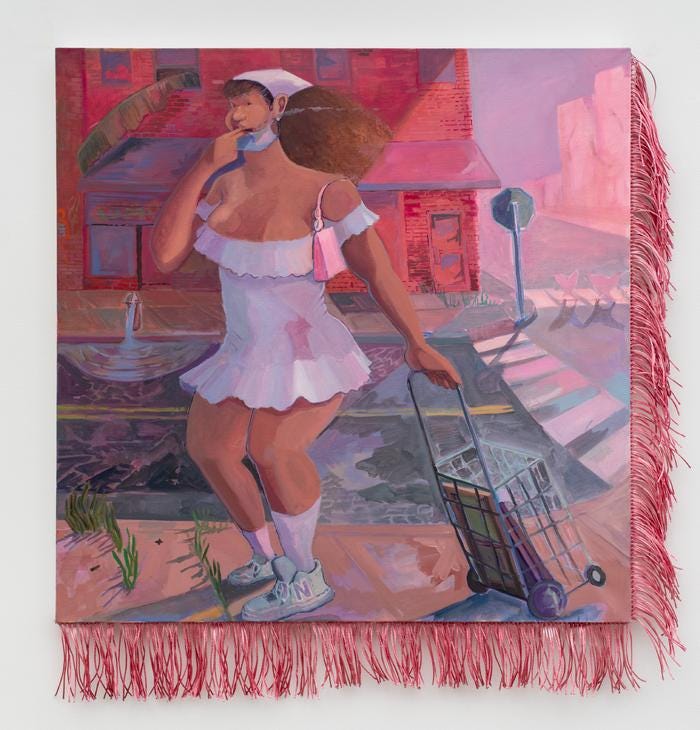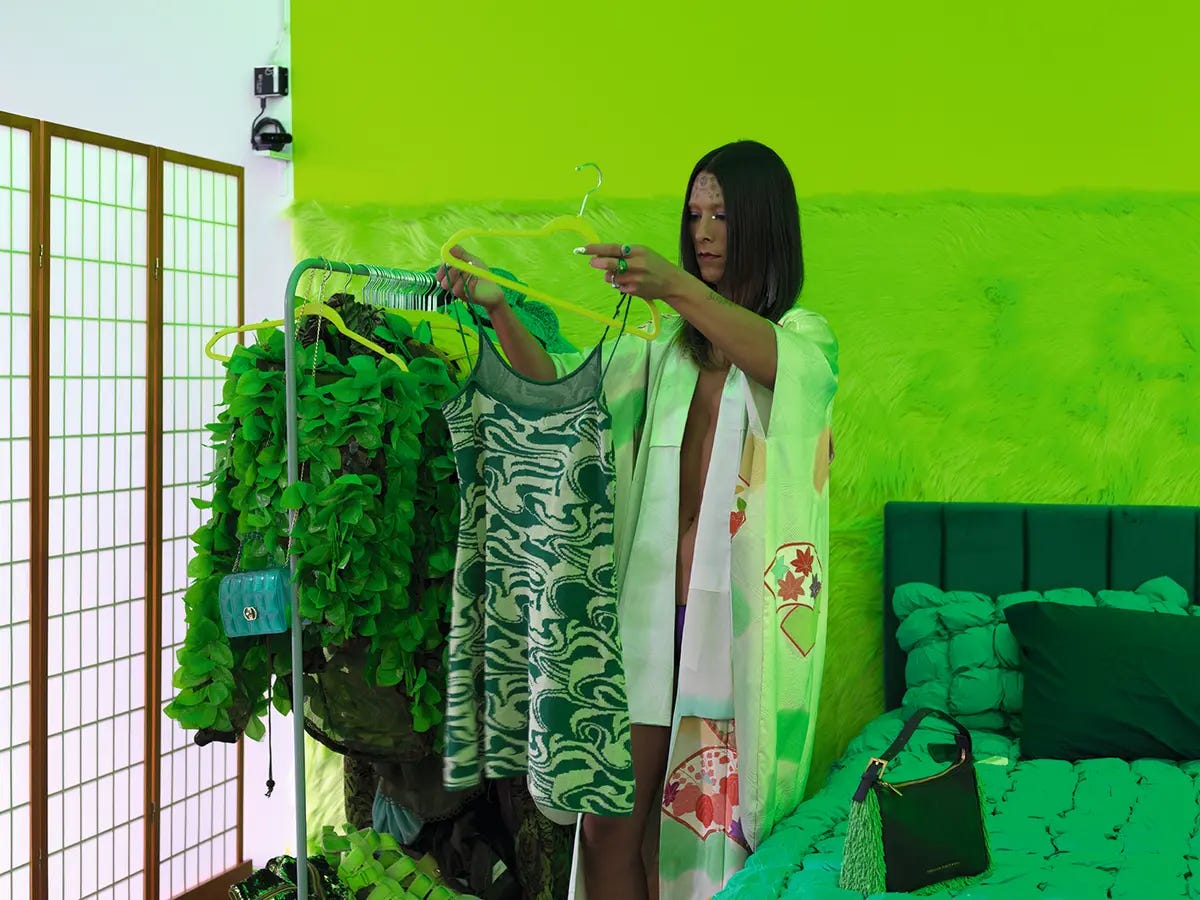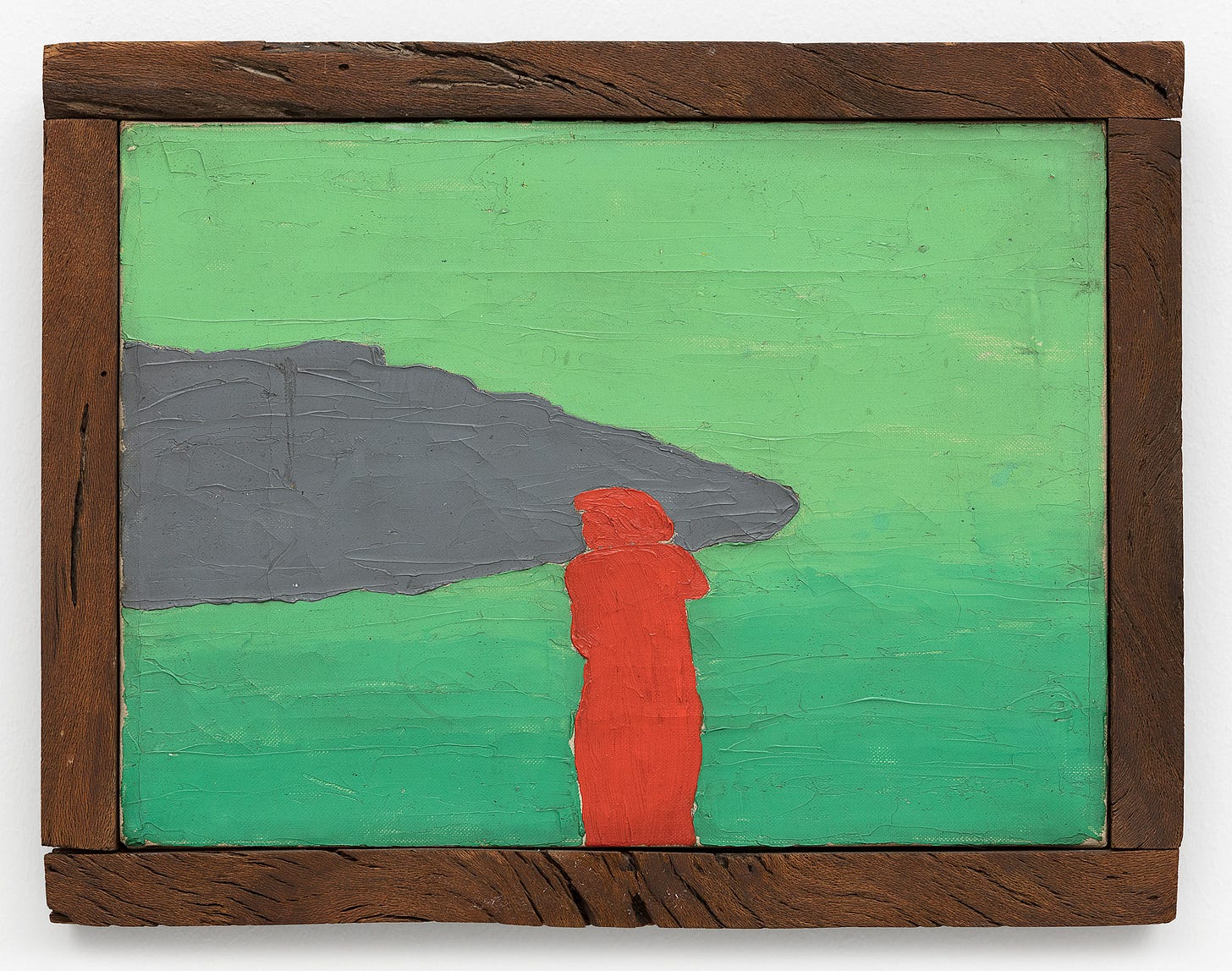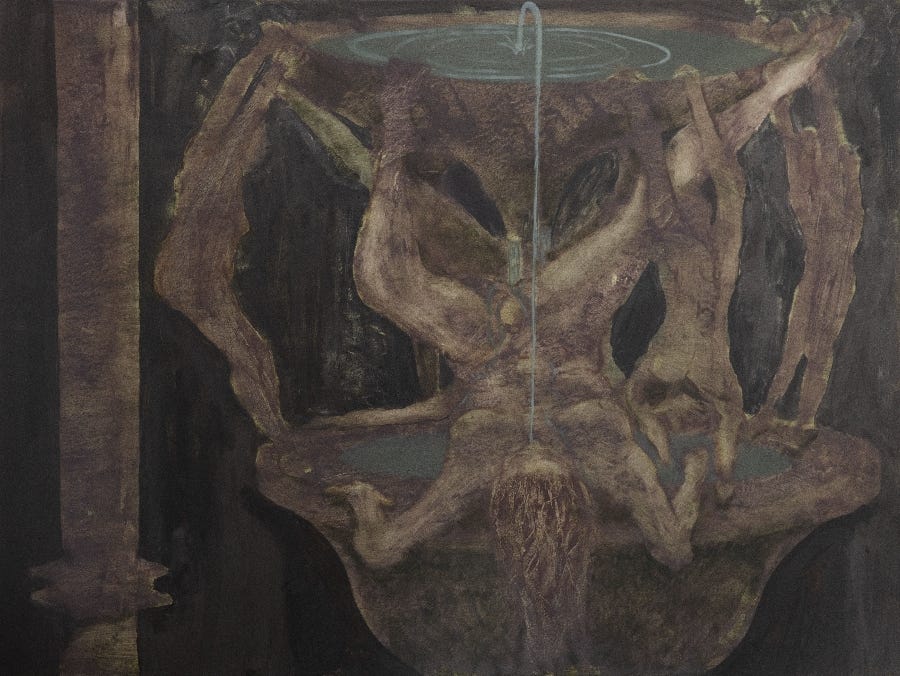Above: Nash Glynn.
Form is not always critiqued as a functional element of trans paintings. Instead, the only function considered concerning trans painting is representation. Here, representation denotes the act of a trans-identified artist to inscribe trans-identity into a painting. She must find a way to put her whole pussy into a painting. The politics of trans representation have been ruthlessly, cringily debated in recent years after the so-called Trans Tipping Point. Is visibility revolutionary? Does more image-making by and of trans people make us more free? Does seeing a trans person live their life contribute to more people believing in trans liberation?
Well we see how that went. While recent political backlash does not void trans representation of any political value, it has certainly not led to a more “just” society. Historically, the trans subject has been demanded to account for herself, both to those who would harm her and those who would fight for her—at least once she shows the goods. The liberal gaze can be benevolent or benign, depending on how in vogue diversity really is.
While not inherently revolutionary, the trans self-portrait can perform many other actions. It can subvert, obscure, enhance, magnify, negate, guard, hold. These verbs can also overlap, producing layered readings for different audiences. These images can be convex or concave; they may repel or attract. How a viewer feels about trans people will certainly affect their experience but so too will how an artist approaches their subject matter. Whether or not they give into kitsch, liberal guilt, or passe ideas of trans joy as inherently radical, there’s a wounded attachment to the idea of representation. It’s a touchy subject. So often transness is an object, not a subject. But here it is both. The portraitist comes home to roost—on her bed, in her cage, or in the mirror. She can either work within or against the grain of liberal ideals of inclusion.
Many early trans women were painters as well as medical pioneers including Lili Elbe (who stopped painting after transitioning), Toni Ebel, and Lorenza Böttner, who all produced self-portraits. Later trans artists like Avery Z. Nelson, El Kazovsky, Jamie Nares, Ser Serpas, Creighton Baxter, or Leidy Churchman often work in abstraction, eschewing a more figurative tradition. This is, of course, a powerful way to evade debates about legibility altogether.
Above: Cielo Félix-Hernández.
There’s an understandable weariness to straightforwardly representational identity-based art. This optimistic approach to portraiture can seem foreign in an irony-laced downtown art scene where obscurity and ephemerality reign supreme. Not all trans art that magnifies or enhances the lived reality of its creator is corny. (Though plenty of it is.) Representational art can still be visually successful. Sometimes it’s even striking. The work of Cielo Félix-Hernández and Nash Glynn is some of the best. Being clear and being obvious are not the same. It’s a fine line to walk. The sublime goes a long way. In the portraits of Cielo Félix-Hernández there are flowers, tattoos, acrylic nails, and bubble-colored hairdos all bathed in a yellow-green glow. Many of her works feature nude women crouching, bathing, gathering eggs, or hauling trolleys. In her recent show “Sweet and Sour” there were many nods to her Puerto Rican heritage. Even her shadows are colorful and optimistic. There is that rare thing: trans joy. Yet Félix-Hernández’s work never comes across as sickly sweet. There’s dignity and poise that she lends to her self-image, whether a cute little pink shoulder bag, a face mask, a translucent blue slip, or a devilish Betty Boop tattoo. The brush strokes are just elusive enough, following in the likes of Nicole Eisenman, Salman Toor, or the blue sheen of Kerry James Marshall. Nash Glynn, on the other hand, makes spare work. Her paintings frequently involve the artist herself in the nude, sitting on a lone chair or posing by a rainbow. In one painting she emerges from the ocean, holding her breasts with her eyes closed in contemplation. Elsewhere she sits on a bed in a red dress or poses near a flower. Blossoms play a strong symbolic role in many trans paintings, perhaps a playful nod to Georgia O’Keeffe’s vaginal depictions of roses and irises. These are not trans women crumbling, they are immersed in their own personhood, unafraid of looking back at the viewer.
Below: Puppies Puppies.
Puppies Puppies, on the other hand, is one of our most confrontational contemporary trans artists. Between two career-spanning shows at the New Museum and the Cleveland Museum of Art over the past year, she’s accomplished a lot in a short span of time. One of her pieces is a statue she made of herself, a trans woman who at the time had not undergone vaginoplasty, with the word “WOMAN” in all caps on the base. She’s known for her various personas and masks. Many of her performances have involved elaborate costumes or performing burials for her deadname. At her massive New Museum installation “Nothing New,” the artist set up a green bedroom on the main floor lobby and stopped in for occasional performances. Trans flags, the Resistance Flag of Borikén, and the Taíno flag were all hung up above the emerald glow. Her image proliferated across the exhibit both explicit and implied.
Above: Willa Wasserman.
Not all trans self-portraiture and image-making is so overt. Sometimes trans artists turn to strategic opacity. Obscuring and subverting expectations is just as valid an artistic strategy as blatantly, sometimes even moreso. Agnes Walden, Willa Wasserman, and Shelley Uckotter are three fixtures of the downtown arts scene whose wet, blurry portraits can be difficult to make out at first glance. Agnes Walden’s visceral portraits of craftsmanship, hammers, starfish, and piss play offer one example of this tricky image-making. It’s slippery. Take another look and you’ll see women on the verge of a stage, volcanic masonry, lips pouting open with possible erotic glee. It’s an elusive form of fantasy, similar to the mythological paintings of Linus Borgo but with less certainty in their subject matter. The brush strokes spiral like crustaceans. Body parts hover, collapse, glow. Willa Wasserman has a similar approach, her translucent halos in a series of “X” paintings that use the body as a vehicle for formal experimentation. Her recent show at Francois Ghebaly was a triumph, a black-and-gold series of misty obscurities. At first glance, one may think these were purely abstract works but on closer inspection one can see the poses into which Wasserman contorts her body and subsequently captures through wild earth tones. Hiding in plain sight, her work comes in all shapes and sizes—tiny orbs of pale mystery. Uckotter takes a similar tact, depicting nightmarish attics with girls standing pantless among discarded relics. Nude and barely clothed women worship Satan, ride toy horses, and dance around canvases thick and crusty with oil pastel. Instead of diving into the good girl mentality, these portraitists harness the claustrophobic power of limbo. In twilight, women can wink, nod, or brandish a gun–as some of Uckotter’s subjects do.
Above: Forrest Bess.
Other artists prefer to nullify prurient viewership altogether. While Forrest Bess is not an explicitly trans artist, his forays into self-castration seem to at least hint at some form of gender variance. As in Bess’ 1966 “Eye of God,” the painter seemed obsessed with the highly charged act of spectatorship. To be seen is to be gendered. His cryptic phallic paintings with dots and stems, fields and cages are all too easy to psychologize based on his own life story. Some of his paintings are cryptically named “Hermaphrodite.” Narrative often finds a way into even the most abstract queer art. This grim negation of identity is hostile to its viewers. Rather than merely obscure, Bess neutralizes our gaze.
At its best, trans art can toy with us. Offer us new ways of subverting the vampiric cis gaze. At worst, it can offer itself up as a sacrifice in a cynical scam to grab more money. Trans women can be girlbosses too. The liberal cis gaze wants nothing more than to profit off lovely portraits that reveal just enough of the social taboo to titillate but not enough to disrupt the pearl-clutching women who hold the purse strings of the art world. Cis gays are ready to shout mother at any trans woman who deigns to show up at the party with a bag of k but rarely actually pony up to buy the hardcore stuff. Therein lies the problem—painting is a commodity, not just an art form. Self-portraitists sell themselves. A little piece of their image and soul over and over. Success based on identity politics is always conditional. Having to play inside of such a narrow box can exact a heavy toll. Visibility invites aggression just as much as admiration. Opacity, negation, and confrontation offer an alternative to playing by the rules. As liberal ideals crumble, new methods to evade simplistic “resistance” style sophistry will be necessary. There is no one right methodology for self-portraitists to choose. Only different strategies. To the left of corny sentimentalism is a wide field of possibility.
Below: Agnes Walden.
On feminist polemics, Dworkin, and bell hooks for Lux.
Review of Sophie Lewis for The Nation.
Interview with Andrea Long Chu for LARB.








